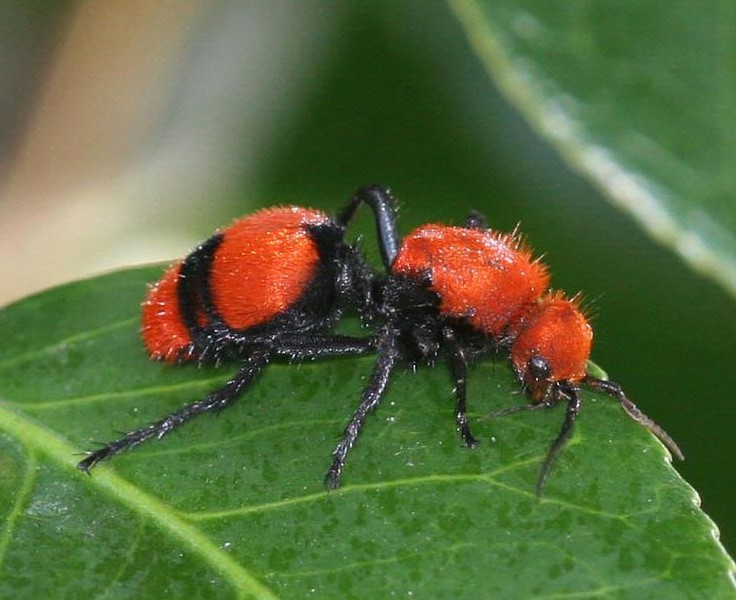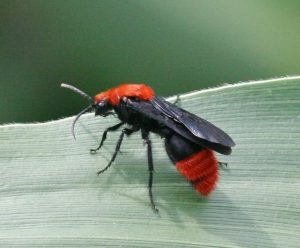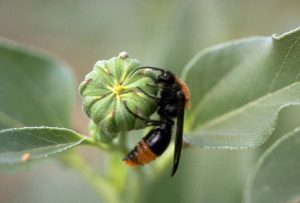
This velvet ant (Dasymutilla occidentalis) is a female, and therefore has no wings, but it does have a long ovipositor that could inflict a painful sting if provoked. Photo by Johnny N. Dell, Bugwood.org.
The Docile Nature of a Cow Killer
Has a large, flashy, bright red-orange, fuzzy ant-like creature ever captured your attention? It may have been the infamous velvet ant, otherwise fittingly known as “cow killer” for the very painful sting it can inflict. A solitary species that builds no nest of their own, you’d likely only see one at a time, perhaps crawling over bare soil or along a tree root.

This velvet ant (Dasymutilla occidentalis) is a male, and therefore has wings, but no stinger. Photo by Johnny N. Dell, Bugwood.org.
Velvet ants are actually not ants at all, but wasps. They are wasps that – although capable of stinging humans and other large animals – are not aggressive and have venom with relatively low toxicity (less than that of a honeybee). That said, an accidental sting by the female’s long ovipositor inflicts serious pain that one would not soon forget.
Velvet ants are in the Mutillidae family, which contain about 8,000 species throughout the world. But only fifty Mutillidae species can be found in Florida, as most prefer arid regions, such as the southwest United States.
If you see a velvet ant with wings, rest assured, it is a male. Although capable of flight, males are incapable of stinging, as they lack stingers. Females, who lack wings, need a suitable host to be able to lay their eggs, and they spend most of their time looking for one. They rely mainly on mature larvae (such as pupae and cocoons) of other solitary species in the Hymenoptera order (other wasps, bees, and ants) to parasitize. That is, a female adult velvet ant will forcibly enter a nest to deposit an egg beside its larval victim. When the velvet ant larva emerges, it will consume this host within about a week before it matures and emerges from the host nest to seek a mate.

Adult velvet ants feed on flower nectar. Photo by Whitney Cranshaw, Colorado State University, Bugwood.org.
The “velvet” part of velvet ant refers to the dense heap of hairs covering top portions of its body, which is usually a bright shade of red or orange, although some species are gold, silver, black, or white. Velvet ants use their aposematic coloration to their advantage. They tell potential predators “don’t mess with me” through their visually striking, often red and black “stripes,” that act as a visual defense mechanism.
Beyond coloration, a female velvet ant will also produce a warning sound when provoked, further evidence that she wishes to remain docile, rather than fight. Despite their gory parasitism on which they rely to reproduce, adults simply feed on nectar.
So, the next time the mesmerizing bright red streak of a velvet ant catches your gaze, keep your distance, but have no fear, for this cow killer comes in peace.
- Yellow Spring Wildflowers in Florida - March 14, 2024
- The Science of Germination - February 1, 2024
- Scraps to Soil: Worm Your Way into Composting - November 9, 2023
